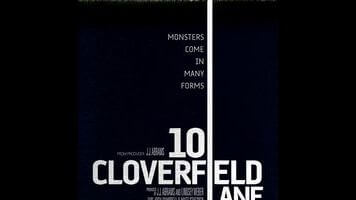The claustrophobic 10 Cloverfield Lane is a sequel mostly just in name

The P.T. Barnum of blockbuster salesmanship, J.J. Abrams makes good movies and better ad campaigns; he doles out pre-release information in tantalizing droplets, getting moviegoers hooked on the mystery he cultivates. But does this strategy always benefit the films themselves? Conceived and shot in near-total secrecy, like a surprise album dropped with little advance notice, 10 Cloverfield Lane follows in the clawed footprints of another project produced but not directed by Abrams: the 2008 mock-doc monster movie Cloverfield. And yet those primed to watch more camera-toting hipsters run for their lives across Manhattan, a skyscraper-sized lizard in hot pursuit, should know that a title is close to all that the new film shares with the old one. On top of that, this “spiritual sequel” seems almost perversely at odds with the expectations it inflates: What comes packaged as a major motion-picture event quickly reveals itself to be something more modest—a pressurized chamber thriller, not an early prelude to the clang-and-bang summer season.
Cloverfield toyed with scope: The film either blew up found-footage horror to city-destroying proportions or squeezed a kaiju movie into the viewfinder of a digital camcorder. The rescaling this time has more to do with franchise logic than genre. How many sequels, spiritual or otherwise, go smaller than the original? 10 Cloverfield Lane does, relocating the conflict from a demolished metropolis to a rural bunker. Here, 40 miles from Lake Charles and some distance below a farmhouse, Michelle (Mary Elizabeth Winstead) awakens from a nasty car crash to find herself shackled to a bed, the unwilling guest of the man who pulled her from the wreckage. Howard (John Goodman) insists that the world above is now a radioactive crater; some one or some thing has made the surface inhospitable, meaning that Michelle will have to rough it in close quarters with Howard and a third party, nice-guy beardo Emmett (The Newsroom’s John Gallagher Jr.), who not only isn’t a prisoner, but actually fought his way down there.
Almost all of 10 Cloverfield Lane takes place in this single location, a cozy underground domicile whose stacks of old board games and working, old-timey jukebox can’t quite chase away the sense of captivity. At first, Michelle thinks of nothing but escape. But soon she begins to wonder if her savior/captor’s paranoid theories aren’t so paranoid after all. Is Howard, who craves gratitude for allowing others into his doomsday shelter, a madman or a prophet? Is the chemical/biological/nuclear threat real, or is all in the head of this humorless military veteran? The high-tension drama pivots around this frightening question mark of motivation, and it’s hard to imagine it operating without Goodman, who splits the difference between workingman weariness and hulking menace better than he has since Barton Fink. (Even in his 60s, the actor remains an intimidating physical presence, capable of chilling bloodstreams without raising his voice—though few bellow as convincingly.) Goodman keeps us (and the characters) guessing throughout, with a vital assist from Whiplash mastermind Damien Chazelle, who co-wrote the screenplay with Josh Campbell and Matthew Stuecken and who knows a thing or two about building suspense from the motives of a hard-ass authority figure.
That none of this unfolds from the perspective of a subjective camera is a relief, even if Cloverfield remains one of the more inventive entries in the ongoing found-footage cycle. First-time director Dan Trachtenberg—an Abrams protégé, just like the original’s Matt Reeves—shoots 10 Cloverfield Lane mostly in claustrophobic close-up, a suitable strategy for studying the shifting allegiances of his surrogate, subterranean family. Setting aside a few stylistic flairs—the opening credits arrive during the auto accident, creating alarming shock cuts to darkness and silence every few seconds—Trachtenberg mostly just trusts his capable cast and the sturdy three-hander cooked up for them. (He also leans heavily on Walking Dead composer Bear McCreary, whose urgent suspense score makes this deliberately small movie feel a little bigger, giving it an extra charge of Spielbergian grandeur.)
The film works so well as a kind of extra-long Twilight Zone episode that it’s kind of disappointing when the scale does increase, during the perhaps inevitable big bang of a climax. Which is to say, carefully and vaguely, that the worse thing about 10 Cloverfield Lane is that it turns out to be a Cloverfield movie. Abrams deserves some credit for taking an unusual approach to franchise building, attempting what John Carpenter tried and failed to do with Halloween—namely, construct an anthology series around a successful brand name. But unfair as it may seem to judge a book through the context of its cover, it’s hard to shake the feeling that the movie’s final moves are an extension of its brilliantly cryptic marketing campaign—in other words, 10 Cloverfield Lane might develop in a more interesting direction if it wasn’t forced to play off the expectations Abrams engineered for it. There’s a fine, nerve-jangling little psychological thriller here. Pity it couldn’t have been allowed to just be that.
For thoughts on, and a place to discuss, plot details we can’t reveal in this review, visit 10 Cloverfield Lane’s spoiler space.